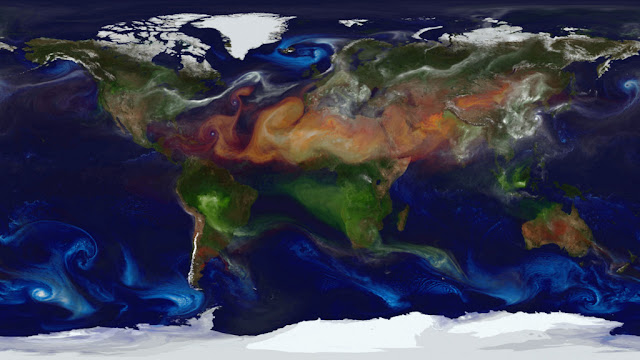In parts I to III of previous
climate modelling posts, we commented general aspects of climate models, how
they work and also the main challenges and difficulties facing modellers. In this fourth and final part of this series
of posts, I want to show you an interesting application of Global Circulation
Models (GCMs).
In Asia, the Mekong River (see
Figure below), which is the 12th longest river in the world with a length of 4,350
kilometres, represents a fundamental source of resources for different economic
activities in Southeast Asia, such as agriculture and fishing. Another
fundamental aspect to consider is the strong intervention of the river with
large hydraulic projects, such as dams for hydropower generation. Due to the river
represents a fundamental source of resources for the different cities and human
settlements located in the basin, interesting studies have been carried out in order to assess the potential effects of climate
change in the Mekong River.
Mekong River
In addition, another significant
contribution was to consider different climate scenarios given by a GCMs
structure. Basically, they built different GCM scenarios working as a base for
a hydrological model (SLURP) of the study area. The fundamental strength of
this methodology was to observe modelled responses of the freshwater behaviour
due to different climate scenarios. Specifically, they generated different
global warming scenarios between 0.5 and 6.0°C. For the 2°C scenario, they used
seven different GCMs. Although there were clear similarities among the GCMs, it
was useful to use different models structures to analyse the influence of these
structures in the final projection uncertainty.
Mekong
River
According to the main purpose of
the study, the effort of researchers was mainly focused on the understanding
and measurement of the model uncertainty. An interesting result was to
find a significant effect on the uncertainty due to the differences in
precipitation projections given by the different GCMs, even for the same
scenario. As we could see in the previous post, one of the most relevant
challenges facing GCMs modellers is to improve precipitation and water cycle
simulation. This was also emphasized by other researchers in a study developed with multiple GCMSs in India, where were
found severe uncertainties in future rainfall estimations. Conversely, a proper
consistency was found in GCMs projection for both snowmelt season and evapotranspiration in the Mekong
river basin.
Finally, the most significant
outcome was related to the strong dependence of hydrological behaviour in the
basin (discharge) with potential changes in precipitation patterns. Due to the
seven GCMs applied and considering the different precipitation estimations of
these, for the 2°C scenario the parameters of the hydrological model were
numerically estimated with an uncertainty between -2.0 – 2.0% and the discharge
pattern was suitably represented by the model (see Figures below).
As we can see, the obtained
results ratify the proposed methodology of applying different GCMs in order to
obtain a suitable estimation of the final uncertainty, minimizing this value
and finally obtaining better projections.
Mekong
River, Parameter Uncertainty for HadCM3 (GCM) Model, 2°C Scenario
Mekong
River, Monthly Discharge for Base – Line and Seven GCMs Applied, 2°C Scenario












